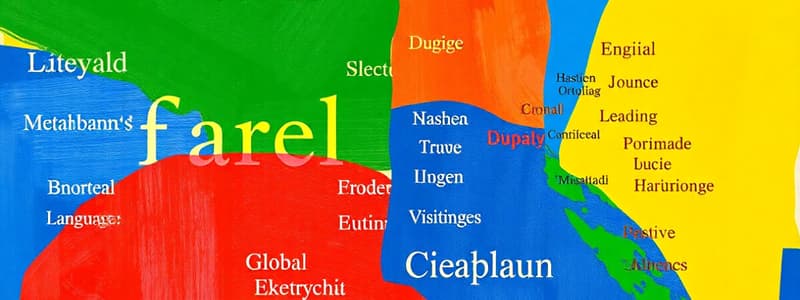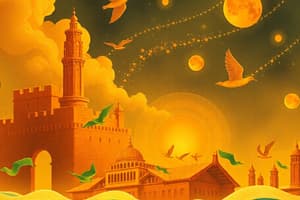Podcast
Questions and Answers
What significant event introduced Middle English to the language?
What significant event introduced Middle English to the language?
- The Anglo-Saxon settlers arriving
- The Norman Conquest (correct)
- The Great Vowel Shift
- The publication of the King James Bible
Which language family does English belong to?
Which language family does English belong to?
- Celtic
- Germanic (correct)
- Sino-Tibetan
- Romance
What was a major change during the Early Modern English period?
What was a major change during the Early Modern English period?
- Standardization of spelling and grammar (correct)
- Reduction in vocabulary size
- Introduction of loanwords from Norse
- Increased use of Old English words
Which of the following is a defining characteristic of Modern English?
Which of the following is a defining characteristic of Modern English?
What is the primary structure of English sentences?
What is the primary structure of English sentences?
Who is a notable author from the English literary tradition?
Who is a notable author from the English literary tradition?
What does etymology study?
What does etymology study?
Which of the following is NOT a part of speech in English grammar?
Which of the following is NOT a part of speech in English grammar?
What impact did the British Empire have on the English language?
What impact did the British Empire have on the English language?
Which of the following best exemplifies a homophone?
Which of the following best exemplifies a homophone?
Flashcards are hidden until you start studying
Study Notes
Overview of the English Language
- Language Family: Germanic branch of the Indo-European family.
- Global Influence: Widely spoken worldwide; first language for about 370 million people and second language for around 1.5 billion.
- Dialects: Includes British English, American English, Australian English, and others.
History
-
Old English (450-1150 AD)
- Originated from Anglo-Saxon settlers.
- Influenced by Latin and Norse languages.
-
Middle English (1150-1500 AD)
- Introduced through the Norman Conquest (1066).
- Influence from French and Latin increased.
-
Early Modern English (1500-1700 AD)
- Standardized spelling and grammar emerged.
- The Great Vowel Shift changed pronunciation.
- Works of Shakespeare and the King James Bible popularized the language.
-
Modern English (1700-Present)
- Continued evolution in vocabulary, slang, and usage.
- Global spread due to British Empire and American influence.
Grammar
- Parts of Speech: Nouns, verbs, adjectives, adverbs, pronouns, prepositions, conjunctions, interjections.
- Sentence Structure: Typically follows a Subject-Verb-Object (SVO) format.
- Tenses: Past, present, and future, each with simple, continuous, perfect, and perfect continuous aspects.
Vocabulary
- Loanwords: Extensive borrowing from languages such as Latin, French, and Norse.
- Etymology: Study of word origins, significant for understanding word meanings.
- Homophones and Homographs: Words that sound the same or are spelled the same but have different meanings (e.g., "bare" vs. "bear").
Pronunciation
- Phonetics: Study of the sounds of English; includes vowels, consonants, and stress patterns.
- Accents: Variations in pronunciation based on region, culture, or social group.
Writing Systems
- Alphabet: Latin alphabet with 26 letters.
- Punctuation: Essential for clarity; includes periods, commas, question marks, etc.
- Styles: Formal (academic, business) vs. informal (conversational, personal).
Literature
- Genres: Poetry, drama, fiction, non-fiction, essays.
- Notable Authors: William Shakespeare, Jane Austen, Charles Dickens, Mark Twain, Virginia Woolf.
Learning English
- Methods: Immersion, formal education, online courses, self-study.
- Resources: Textbooks, language apps, podcasts, media consumption (films, books, news).
Cultural Impact
- Media and Entertainment: Dominance in music, film, literature, and the internet.
- Business and Technology: Preferred language in international business and tech industries.
English Language Overview
- Belongs to the Germanic branch of the Indo-European language family.
- Approximately 370 million native speakers and 1.5 billion second-language speakers globally.
- Significant dialects include British, American, and Australian English, among others.
Historical Development
- Old English (450-1150 AD): Anglo-Saxon origins, influenced by Latin and Norse.
- Middle English (1150-1500 AD): Norman Conquest introduced French and further Latin influence.
- Early Modern English (1500-1700 AD): Spelling and grammar standardization, the Great Vowel Shift impacting pronunciation, Shakespeare and the King James Bible shaping the language.
- Modern English (1700-Present): Ongoing vocabulary, slang, and usage evolution; global spread via the British Empire and American influence.
Grammatical Structure
- Eight main parts of speech: nouns, verbs, adjectives, adverbs, pronouns, prepositions, conjunctions, and interjections.
- Predominantly Subject-Verb-Object (SVO) sentence structure.
- Three main tenses (past, present, future), each with simple, continuous, perfect, and perfect continuous aspects.
Vocabulary and Word Usage
- Rich vocabulary with extensive loanwords from Latin, French, and Norse.
- Etymology crucial for understanding word meanings.
- Includes homophones (same sound, different meaning) and homographs (same spelling, different meaning)
Pronunciation and Sounds
- Phonetics studies English sounds (vowels, consonants, stress).
- Regional, cultural, and social variations create diverse accents.
Writing System
- Uses the 26-letter Latin alphabet.
- Punctuation essential for clarity (periods, commas, question marks, etc.).
- Writing styles vary between formal (academic, business) and informal (conversational).
Literary Landscape
- Diverse genres: poetry, drama, fiction, non-fiction, and essays.
- Influential authors: Shakespeare, Austen, Dickens, Twain, Woolf, and many others.
Learning and Resources
- Learning methods include immersion, formal education, online courses, and self-study.
- Resources range from textbooks and language apps to podcasts and media (films, books, news).
Cultural Impact
- Dominant language in media (music, film, literature, internet) and international business/technology.
Studying That Suits You
Use AI to generate personalized quizzes and flashcards to suit your learning preferences.




